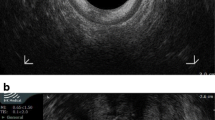Abstract
Purpose
The etiology of fecal incontinence is multifactorial. We hypothesize that women who seek treatment at different ages differ. We sought to determine which characteristics of women with fecal incontinence patients are associated with younger age at presentation.
Methods
We reviewed a database of 399 women with complete fecal incontinence evaluations from 2001 to 2006, selecting patients who were aged 49 and younger or aged 65 years and older, for a total of 246 patients. Data were obtained from self-report questionnaires on fecal incontinence frequency and associated symptoms, medical history, and results of anorectal physiology tests. Univariate and multivariate analyses were performed.
Results
The median ages of the two groups were 42 (range, 23–49) years and 72 (range, 65–89) years. Sphincter defects > 90 degrees and previous sphincteroplasty were associated with the younger age group. Previous hemorrhoid surgery and bilateral pudendal neuropathy were associated with the older age group. Younger women had more frequent incontinence to gas, mucus, and liquid stool.
Conclusions
In our cohort, fecal incontinence-related symptoms and medical conditions differed in older and younger women presenting with this condition. Younger women may be more likely to seek treatment for any degree of symptoms. The differing characteristics of fecal incontinence by age should be considered when developing a treatment strategy.

Similar content being viewed by others
References
Nelson R, Norton N, Cautley E, Furner S. Community-based prevalence of anal incontinence. JAMA 1995;274:559–61.
Goode PS, Burgio KL, Halli AD, et al. Prevalence and correlates of fecal incontinence in community-dwelling older adults. J Am Geriatr Soc 2005;53:629–35.
Quander CR, Morris MC, Melson J, Bienias JL, Evans DA. Prevalence of and factors associated with fecal incontinence in a large community study of older individuals. Am J Gastroenterol 2005;100:905–9.
Boreham MK, Richter HE, Kenton KS, et al. Anal incontinence in women presenting for gynecologic care: prevalence, risk factors, and impact upon quality of life. Am J Obstet Gynecol 2005;192:1637–42.
Melville JL, Fan MY, Newton K, Fenner D. Fecal incontinence in US women: a population-based study. Am J Obstet Gynecol 2005;193:2071–6.
Perry S, Shaw C, McGrother C, et al. Prevalence of faecal incontinence in adults aged 40 years or more living in the community. Gut 2002;50:480–4.
Frudinger A, Halligan S, Bartram CI, Price AB, Kamm MA, Winter R. Woman anal sphincter: age-related differences in asymptomatic volunteers with high-frequency endoanal US. Radiology 2002;224:417–23.
Rociu E, Stoker J, Eijkemans MJ, Lameris JS. Normal anal sphincter anatomy and age- and sex-related variations at high-spatial-resolution endoanal MR imaging. Radiology 2000;217:395–401.
Oberwalder M, Dinnewitzer A, Baig MK, et al. The association between late-onset fecal incontinence and obstetric anal sphincter defects. Arch Surg 2004;139:429–32.
Varma MG, Brown JS, Creasman JM, et al. Fecal incontinence in women older than aged 40 years: who is at risk? Dis Colon Rectum 2006;49:841–51.
Crowell MD, Lacy BE, Schettler VA, Dineen TN, Olden KW, Talley NJ. Subtypes of anal incontinence associated with bowel dysfunction: clinical, physiologic, and psychosocial characterization. Dis Colon Rectum 2004;47:1627–35.
Rockwood TH, Church JM, Fleshman JW, et al. Patient and surgeon ranking of the severity of symptoms associated with fecal incontinence: the fecal incontinence severity index. Dis Colon Rectum 1999;42:1525–32.
Rockwood TH, Church JM, Fleshman JW, et al. Fecal Incontinence Quality of Life Scale: quality of life instrument for patients with fecal incontinence. Dis Colon Rectum 2000;43:9–16.
Talley NJ, O’Keefe EA, Zinsmeister AR, Melton LJ 3rd. Prevalence of gastrointestinal symptoms in the elderly: a population-based study. Gastroenterology 1992;102:895–901.
Hill K. The demography of menopause. Maturitas 1996;23:113–27.
Lunniss PJ, Gladman MA, Hetzer FH, Williams NS, Scott SM. Risk factors in acquired faecal incontinence. J R Soc Med 2004;97:111–6.
Chaliha C, Sultan AH, Emmanuel AV. Normal ranges for anorectal manometry and sensation in women of reproductive age. Colorectal Dis 2007;9:839–44.
Fox JC, Fletcher JG, Zinsmeister AR, Seide B, Riederer SJ, Bharucha AE. Effect of aging on anorectal and pelvic floor functions in women. Dis Colon Rectum 2006;49:1726–35.
Read NW, Abouzekry L, Read MG, Howell P, Ottewell D, Donnelly TC. Anorectal function in elderly patients with fecal impaction. Gastroenterology 1985;89:959–66.
Tobin GW, Brocklehurst JC. Faecal incontinence in residential homes for the elderly: prevalence, aetiology and management. Age Ageing 1986;15:41–6.
Author information
Authors and Affiliations
Corresponding author
Additional information
Reprints are not available.
About this article
Cite this article
Wang, J.Y., Patterson, T.R., Hart, S.L. et al. Fecal Incontinence: Does Age Matter? Characteristics of Older vs. Younger Women Presenting for Treatment of Fecal Incontinence. Dis Colon Rectum 51, 426–431 (2008). https://doi.org/10.1007/s10350-007-9138-7
Received:
Revised:
Accepted:
Published:
Issue Date:
DOI: https://doi.org/10.1007/s10350-007-9138-7




